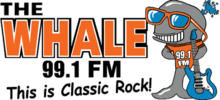WAAL
WAAL (99.1 MHz "The Whale") is a commercial FM radio station licensed to Binghamton, New York. It airs a classic rock radio format and is owned by Townsquare Media. WAAL is the oldest FM radio station in the Binghamton metropolitan area. It is an affiliate of the New York Giants Radio Network.
 | |
| City | Binghamton, New York |
|---|---|
| Broadcast area | Binghamton metropolitan area - Southern Tier |
| Frequency | 99.1 MHz |
| Branding | 99.1 The Whale |
| Slogan | "Binghamton's Classic Rock" |
| Programming | |
| Format | Classic Rock |
| Affiliations | New York Giants Radio Network |
| Ownership | |
| Owner | Townsquare Media (Townsquare Media Binghamton License, LLC) |
| Sister stations | WHWK, WNBF, WWYL, WYOS |
| History | |
| First air date | March 1954 (as 95.3 WKOP-FM) |
| Former call signs | WKOP (1954-1975) |
| Call sign meaning | Play on the word "Whale" |
| Technical information | |
| Facility ID | 7920 |
| Class | B |
| ERP | 8,700 watts |
| HAAT | 291 meters (955 ft) |
| Links | |
| Webcast | Listen Live |
| Website | 991TheWhale.com |
The studios and offices are on Court Street in Binghamton.[1] The transmitter is off Ingraham Hill Road, also in Binghamton, amid other towers for local TV and FM stations.[2]
History
WKOP-FM
In March 1954, the station signed on as WKOP-FM at 95.3 MHz.[3] It was the FM counterpart of AM 1360 WKOP (now WYOS). The two stations simulcast and were network affiliates of the Mutual Broadcasting System. They were owned by Binghamton Broadcasters, Inc. At first, WKOP-FM broadcast at only 420 watts, a fraction of the station's current power.
In the 1960s, WKOP-FM received Federal Communications Commission (FCC) permission to move to 99.1 MHz, with an increase in power to 33,000 watts.[4] By 1970, it ended its simulcast with WKOP 1360 and began playing a progressive rock format.
WAAL
In 1975, the station was sold to Butternut Broadcasting, which switched the call sign to WAAL.[5] The station was known as "WAAL (pronounced like whale) Stereo FM 99." In the late 1980s and early 1990s, it was known as "The Hot FM," playing Top 40 hits. It was affiliated with the ABC FM Network.
WAAL changed hands again in 1990, along with AM 1360, know then as WBSK. The two stations came under the ownership of All Channel TV Service.[6] 1996 brought another ownership change, this time to Wicks Broadcasting, which changed WAAL's format to classic rock.
Citadel Ownership, then Townsquare
WAAL was acquired by Citadel Broadcasting in 1998 from Wicks Broadcast Group in a $77 million deal that included a total of 16 radio stations.[7] Citadel merged with Cumulus Media on September 16, 2011.[8]
In 2013, in a $281 million, multi-staton deal involving Cumulus, Townsquare Media and Peak Broadcasting, 99.1 WAAL and AM 1360, now known as WYOS, were acquired by Townsquare.[9] The classic rock format has remained in place on WAAL.
On-air lineup
- The Freezone with Jim Free - 5am-10am, Monday - Friday
- Nikki Cruz - 10am-3pm, Monday - Friday
- Don Morgan- 3pm-7pm, Monday - Friday
- Ultimate Classic Rock with Uncle Joe Benson - 7pm-Midnight, Monday - Friday
On Air Alumni - The Oz, Pete Bucky, Big Wally, Thunder Reynolds, Rick Kelly, Mr. Mandyke, Steve Willet, The Wildman, The Banana Queen, John Carter, Doug Mosher, Captain, Doc Wells
Shows
- The Whale Morning Show - Jim Free and the Free Zone from 5am-10am on weekdays, with contests, music news, traffic, weather and comedy.
- 6 Pack Classic Rock Ride - Features at least six Classic Rock songs in a row, after the Whale Morning Show.
- Little Steven's Underground Garage - A syndicated show from Steven Van Zandt of The Sopranos and the E Street Band - Sundays at 10pm.
- The Southern Tier Closeup - Sundays at 6am, hosted by Kathy Whyte, a radio program showcasing community issues.
- Time Warp - Sundays at 8am, a syndicated 4-hour classic rock radio show hosted by Bill St. James.
- The Beatle Years - Bob Malik hosts a syndicated show about the band that defined a generation - Sunday at 7am
References
- 991TheWhale.com/help
- Radio-Locator.com/WAAL
- Broadcasting Yearbook 1955 page 210
- Broadcasting Yearbook 1970 page B-134
- Broadcasting Yearbook 1978 page C-144
- Broadcasting Yearbook 1991 page B-219
- Citadel Communications Acquires 16 Radio Stations From Wicks Broadcast Group for $77 Million
- "Cumulus now owns Citadel Broadcasting". Atlanta Business Journal. September 16, 2011. Retrieved September 16, 2011.
- TownsquareMedia.com/press/"Townsquare Acquiring Assets from Cumulus and Peak"
External links
- 99.1 The Whale - Official Site
- The Whale Morning Crew
- The Rockin' 80's - Official Site
- Big Wally's MySpace
- WAAL in the FCC's FM station database
- WAAL on Radio-Locator
- WAAL in Nielsen Audio's FM station database